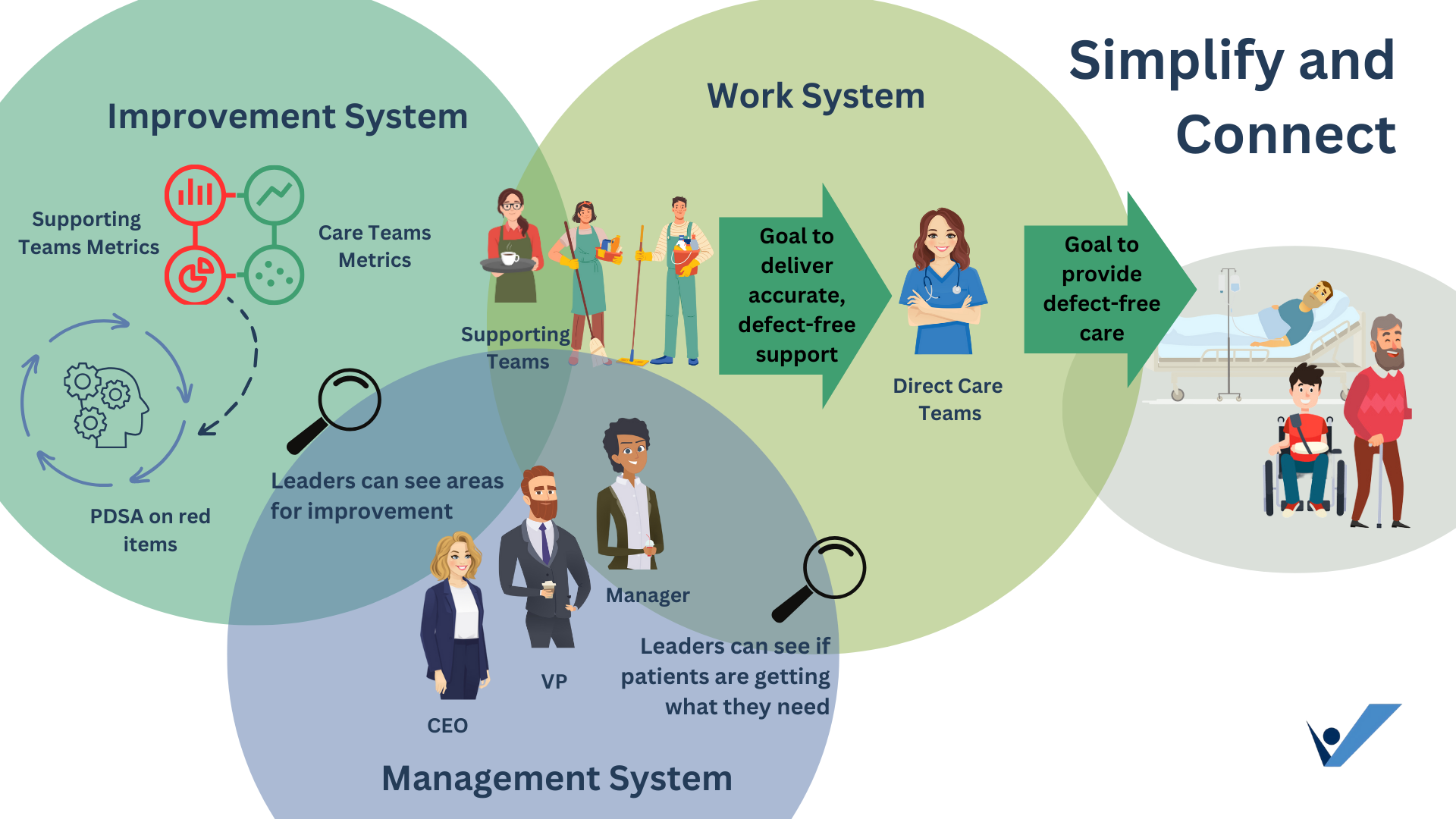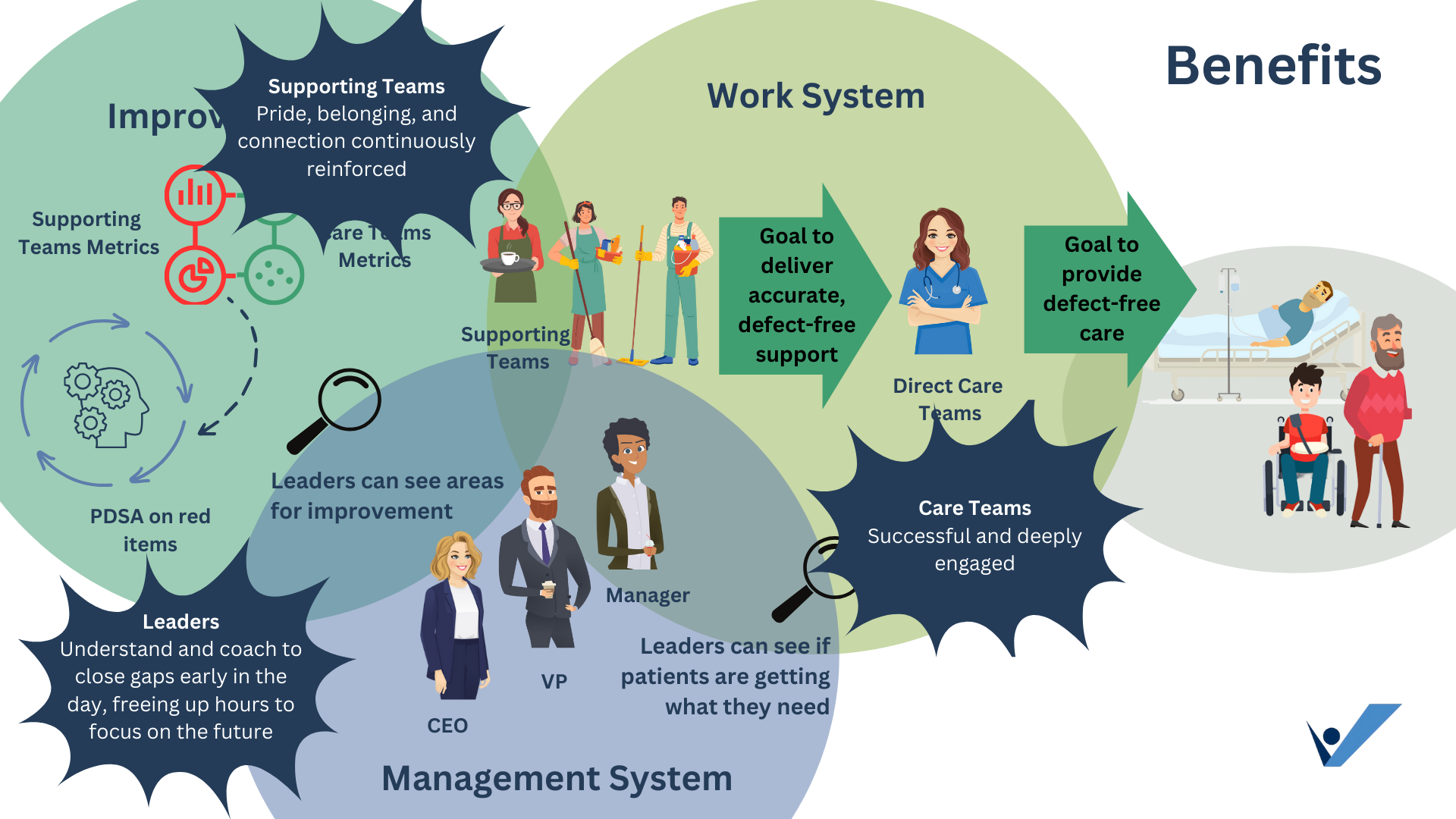Times are challenging in the healthcare industry now. Systems are going through mergers and acquisitions, disruptors are entering the market, and staffing shortages. Many healthcare executives wrestle with conflicting imperatives. On the one hand, health systems face financial pressures, safety and quality issues, and patient and staff dissatisfaction that must be addressed. On the other hand, Executives need to look forward and focus on strategy, innovation, and growth.
Through all this, several healthcare systems have found a way to achieve amazing and sustainable results while freeing up the capacity to look toward the future.
How is this possible?
Simplify and connect
To get the results you are looking for, first, you need to focus on the work system; or the processes that go into providing value for your patients. Begin with the support teams (like food service and environmental services teams), and then spread to the direct care teams. The goal for supporting teams should be to deliver accurate, defect-free support, while the goal of the direct care teams is to provide defect-free care to the patients. The reason to start with support teams is that it will help free up time and stress for the direct care teams. One example we often use is if a food tray is delivered and missing an item, the nurse will have to spend time contacting food services to request the item, rather than using that time to care for a patient.
Next, you need to connect your improvement system with the work. The system should gather metrics from support teams and direct care teams and focus on improving the items that do not meet the target. This process will help staff learn PDCA thinking and progress to real-time problem solving and make the gaps visible to everyone.
Finally, you will also need to implement a management system that enables leaders to see the areas of improvement throughout the organization and allows them to see if patients are getting what they need.

How is this different?
You might be thinking that this is what we are doing and we still aren’t getting the results or efficiencies that we are seeking. One reason may be that you are putting too much emphasis on your management system and not enough on the work systems. You can read more about that in this blog post by Ken Segel. Another reason might be that you are not working with the support teams. Many hospitals and health systems start by improving works systems for direct care teams and neglect the support teams.
This approach is different in some key ways:
- Single customer/supplier connections – avoid confusion in the work system and processes by creating direct connections and handoffs with clear signals.
- Reporting on one metric per connection – often we see organizations reporting and trying to improve on so many metrics that can overwhelm teams. If you can focus on one measure, improve and stabilize, then move to another you are likely to have more success.
- Simplified, transparent, flow-based huddle – don’t try to do too much with your huddles. The point is to escalate information up the organization when needed and provide transparency in performance.
- Real-time problem-solving for both safety and customer-supplier misses – solving problems in real-time is more effective than reporting an issue and then looking into it after the fact.

What are the benefits?
When all three systems; the work system, the improvement system, and the management system are in place and working together they benefit everyone in the organization. The support teams feel a sense of pride and belonging, and their connection to the organization’s mission is continuously reinforced. This is because they can see how their work impacts everyone and feel part of the larger team versus on the outskirts feeling ignored. Care teams are more successful and become deeply engaged since they will have more time to focus on the patients, which is likely why they got into their profession in the first place. And leaders can understand performance gaps early, which allows them to coach teams to close them and frees up time to focus on the future of the organization, rather than being wrapped up in operations most of the time.

This approach to an operating system promotes alignment between leaders and team values. It creates stability, agility, momentum, and pride for teams and achieves results for patients and organizations.
Resources
Learn more about this approach and more at our Executive Seminar: Enduring Excellence
Check out this podcast to hear about what this looks like in action
Read more about the model

Written by Value Capture, LLC
We are consultants who act as trusted advisors that guide health systems determined to produce perfect health with zero harm, wait, or waste — for patients, teams, and communities. We work with organizations by solving their biggest problem and doing it in a sustainable way, with “no tradeoffs” leading to exceptional change in organizations and the knowledge to continue to improve.

Submit a comment